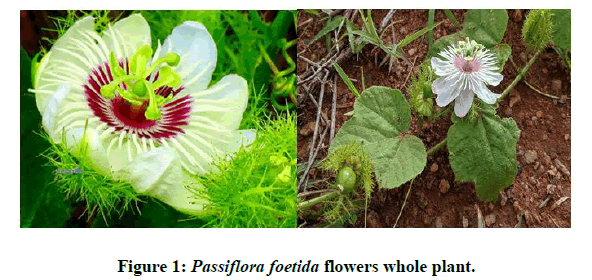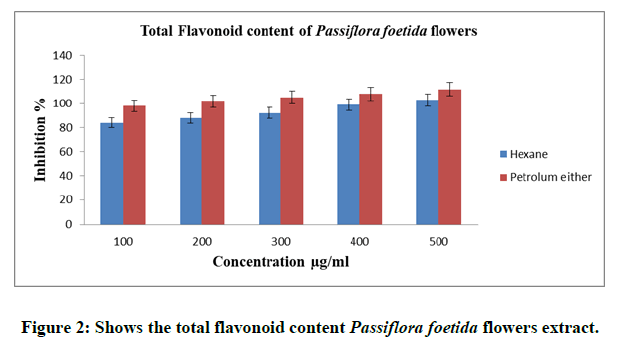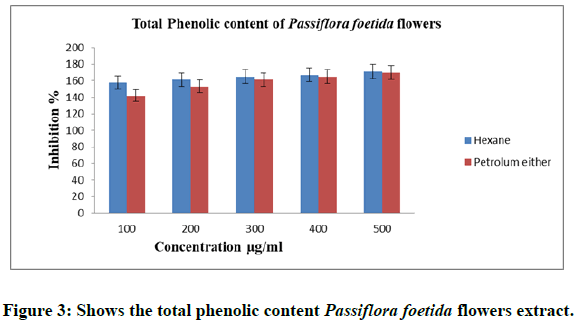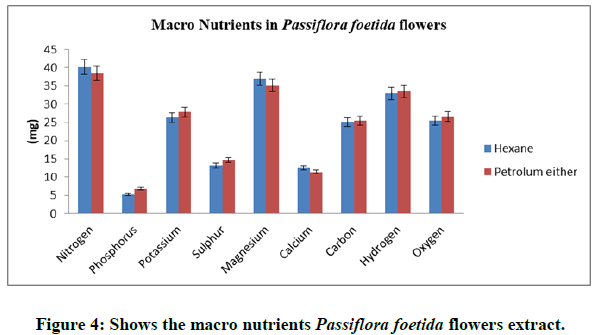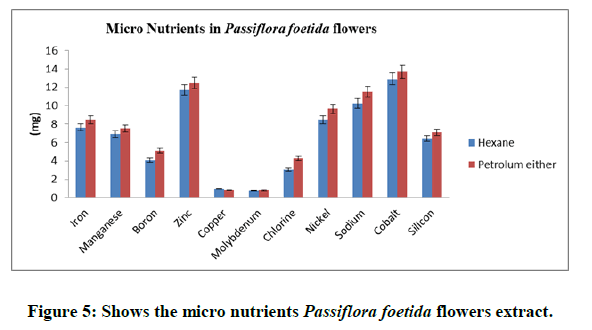Original Articles: 2023 Vol: 15 Issue: 5
Phytochemical Identification and Antioxidant Activity of Passiflora Foetida Hexane, Petroleum Ether Flowers Extracts
Baskaran K*, Dinesh raja S, Sijo henry, Namitha V, Safana A, Abishek M, Haseera N, Shalet Varghese
Department of Biochemistry, Sree Narayana Guru College, Coimbatore, Tamilnadu, India
- Corresponding Author:
- Baskaran K
Department of Biochemistry,
Sree Narayana Guru College,
Coimbatore,
Tamilnadu,
India
Received: 08-Mar-2023, Manuscript No. JOCPR-23-91103; Editor assigned: 10-Mar-2023, PreQC No. JOCPR-23- 91103 (PQ); Reviewed: 24-Mar-2023, QC No. JOCPR-23-91103; Revised: 08-May-2023, Manuscript No. JOCPR-23-91103 (R); Published: 16-May-2023, DOI:10.37532/0975-7384.2023.15(5).045.
Citation: Baskaran K, et al. 2023. Phytochemical Identification and Antioxidant Activity of Passiflora Foetida Hexane, Petroleum Ether Flowers Extracts. J Chem Pharm Res., 15:045.
Copyright: © 2023 Baskaran K, et al. This is an open-access article distributed under the terms of the Creative Commons Attribution License, which permits unrestricted use, distribution, and reproduction in any medium, provided the original author and source are credited.
Abstract
This investigation compared the phytochemical composition and antioxidant potential of a flower extract from Passiflora foetida. The criteria found in this study included the total phenolic and total flavonoid content, as well as macro and micro components, for the phytochemicals alkaloid, flavonoid, phenolic, sterol, triterpenoid, saponin, tannin, and cardiac glycoside. The phytochemical components identified in the extract of Passiflora flowers include alkaloids, phenolics, flavonoids, saponins, and cardiac glycosides. Total flavonoids were 145.531.02 mg CE/g sample dry base, and total phenol was 96.920.18 mg GAE/g sample dry base. As a result, Passiflora foetida flower extract in ethanol and chloroform displays a diversity of compounds and may have been used in traditional medicine to treat a variety of diseases.
Keywords
Passiflora foetida, Phytochemical, Antioxidant, Leaf extract, flavonoid content, Chloroform
Introduction
Passiflora foetida, often known as rambusa, is a wild plant that typically grows on other plants in tropical areas. Passiflora foetida, which can also be ingested raw as lalapan, can be used to cure fever, headaches, and asthma. Passiflora foetida is a member of the Passifloraceae family and often grows in damp areas like swamps and rivers [1].
Passiflora foetida is a plant that has been used as a traditional medicine because it contains phytochemicals. Antioxidants can be made from the alkaloid, phenolic, glycoside, flavonoid, and cyanogenic phytochemicals present in Passiflora foetida. The primary phytochemicals in this plant are alkaloids, phenols, glycoside flavonoids, cyanogenic compounds, passifloricins, polyketides, and alpha-pyrones. The majority of the active components of P. foetida L. are C-glycosyl flavones based on apigenin and luteolin, but trace amounts of sucrose, volatile oil, and Harman alkaloids are also present [2-8]. A polyacetylenic molecule found in passion flower Passicol, which has antibacterial properties, has not yet been discovered in P. foetida L.Passiflora foetida has a long history of usage in medicine [9-14].
Since ancient times, several varieties of passion flowers have been used in traditional medicine to alleviate ailments in their natural habitats. In Central America, 2 lobed leaves are attached to leaves from a variety of Passiflora species and used as a diuretic [15].
Indians utilise the unripe fruit of P. foetida as an emetic, and a decoction made from the dry herbage of P. foetida is thought to have diuretic properties. Figure 1 demonstrates how the flowers can treat biliousness and asthma. Hysteria may be treated with a decoction of the leaves and roots of P. foetida. Giddiness and headaches can be alleviated by applying a paste made of leaves to the head [16]. P. foetida is applied topically to treat erysipelas and other inflammatory skin disorders in countries like Brazil. Medical uses: This species can be used as an anti-inflammatory and to treat gastrointestinal conditions like dyspepsia and diarrhea (Figure 1) [17].
Instead, it's used as an astringent and expectorant for spasms and nerve diseases.
The anti-inflammation, anti-tumor, anti-cancer, and anti-microbe activities of Passiflora foetida are among its pharmacological and biological effects [18]. As a result, greater investigation into Passiflora foetida flowers as a source of antioxidants is needed. The phytochemical makeup and antioxidant activity of extracts from Passiflora foetida flowers were compared in this study.
Materials and Methods
Plant material- identification and authentication
The Passiflora foetida flower was carefully selected and taken out of the plant at Sree Narayana Guru College in KG. Chavadi, Coimbatore by a plant taxonomist. Then the flower was identified.
Preparation of Passiflora foetida flower extract
After being cleaned and dried at 40°C in a hot air oven, the Passiflora foetida flower was ground into a fine powder using an electric grinder. Overnight at 60 to 80 degrees Celsius, the material was delipidated using hexane and petroleum ether. Soxhalation involved the use of 95% ethanol. Ethanol was evaporated in a rotating evaporator running at a reduced pressure and 40°C-50°C. The flower's dry weight was extracted as extract to the tune of 13.5% [19].
Phytochemical identification
To detect the phytochemical composition of Passiflora foetida leaves and fruit extracts, such as alkaloid, flavonoid, phenolic, sterol, triterpenoid, saponin, tannin, and cardiac glycoside, phytochemical identification was carried out [20].
Total phenol analysis
Spectrometry was used to measure the total amount of phenol. A 100 l sample received 1 ml of Folin Ciocalteu 10% and 2 ml of Sodium Carbonate 7.5%. The mixture was combined with water in a 10 ml volumetric flask, and then shaken. The sample's absorbance at 760 nm was measured after 30 minutes of incubation at room temperature. The total phenolic content of the sample was determined using the gallic acid equivalence (GAE)/g sample dry base [21].
Total flavonoid analysis
AlCl3 colorimetry was used to calculate the total flavonoid content. 100 l of sample was combined with 0.3 ml NaNO2 5% (b/v), 0.3 ml AlCl3 10% (b/v), and 2 ml NaOH 1 M in a 10 ml volumetric flask. Water was added, and the mixture was agitated until it had a volume of 10 ml. At 510 nm, the sample's absorbance was determined. The sample's total flavonoid content was determined using the formula catechin equivalence (CE)/g dry sample [22].
Mineral concentration
Trace minerals such as Cu, Co, Fe, Mg, Na, K, Ca and Zn were estimated in concentrate hexane and petroleum ether extract of Passiflora foetida flowers using an atomic absorption spectrophotometer (ECIL-Elements, India, model no. 1381, ESPIO, Japan AccucareTM Magnesium Xylidyl Blue, ECIL-Elements AAS 4141). G mg-1 of extract served as the standard unit of measurement for all results [23].
Statistical analysis
The assay runs were duplicated three times each. Experimental data are expressed in terms of the mean and standard deviation. The data were analysed using SPSS version 16's one-way analysis of variance, with Duncan's multiple range tests used to compare the group means [24].
Results and Discussion
There is dampness close by the dried flowers of Passiflora foetida. The phytochemical elements indicated in Table 1 were present in hexane and petroleum ether extracts of Passiflora foetida flowers. Flowers contain cardiac glycoside, phenolic molecules, alkaloids, and flavonoids, according to research. Aqua dest, a polar solvent, was used to extract the nonpolar molecules terpenoid and sterol. The plant includes tannin, an active component that is water soluble. In this experiment, no extract contained tannin. A different inference was made from those who found tannin in both extract and Passiflora flowers (Table 1). The variance in the results was caused by a changing growth environment for plants, which can alter their nutritional value and phytochemical composition. Figures 2, 3 exhibit flavonoid and total phenol, respectively.
| S. No | Qualitative test | Passiflora foetida flowers extract | |
|---|---|---|---|
| Hexane | Petroleum ether | ||
| 1 | Proteins | - | + |
| 2 | Carbohydrates | + | - |
| 3 | Phenols | - | + |
| 4 | Tannins | + | + |
| 5 | Flavonoids | + | + |
| 6 | Sapoins | - | + |
| 7 | Glycosides | + | + |
| 8 | Steroids | + | + |
| 9 | Terpenoids | - | + |
| 10 | Alkaloids | + | - |
Table 1: Shows the phytochemical screening of Passiflora foetida flowers extract.
The total phenol and flavonoid content of the Passiflora flowers petroleum ether extract was lower (96.920.18 mg GAE/g Sample dry base and 82.010.10 mg CE/g Sample dry base, respectively) than that of the Passiflora flowers hexane extract (145.531.02 mg GAE/g Sample dry base and 120.560.27 mg CE/g Sample dry base). Two factors that affect the total phenolic content are the sample's free hydroxyl group content and the activity of the enzymes Phenylalanine Ammonia-Lyase (PAL) and Chalcone Synthase (CHS) in plants.
The creation of chalcone molecules, which the CHI enzyme (Chalcone Isomerase) then isomerizes into diverse flavonol compounds, is a result of the CHS enzymes' influence on the generation of flavonoids.
The total phenol and flavonoid content of the extracts from Passiflora flowers varied due to the varying functions and nutritional makeup of each part of the plant. Flowers are used for photosynthesis and as food storage, while fruit protects seeds by covering them in flesh that is rich in minerals, simple organic compounds, and substrate and facilitates dispersal. Trace minerals are essential for many physiological processes, including DNA synthesis and maintenance, the growth and repair of body tissues, and the formation of ligaments and tendons.
In addition to being essential for the development and maintenance of bones and muscles, macro and micro minerals also play a critical role in the prevention of chronic illnesses, high blood pressure, and depression.
In addition to being essential for enzyme activity, magnesium also aids in the prevention of heart disease and interferes with nerve and muscle impulse transmission, causing irritability and agitation. Both macro and micro factors were included in the current study's Passiflora foetida hexane and petroleum ether extracts (Figures 4 and 5).
CONCLUSION
The plant Passiflora foetida reportedly contains phytochemicals such glycosides, alkaloids, saponins, phenolic compounds, carbohydrates, tannins, proteins, amino acids, and triterpenoids, according to the current study. Each phytochemical has a unique set of medicinal qualities. According to this study, Passiflora flowers extract had greater levels of total phenol, total flavonoid, macro and microminerals, and other compounds.
ACKNOWLEDGEMENT
We thank Dr. D. Kaplana. Principal, Sree Narayana Guru College, for the facilities provided is gratefully acknowledged.
References
- Lim TK. Fruits. 2012;4:166-172.
- Quattrocchi U. CRC Press. Newyork, USA. 2012; 2803-2804.
- Dhawan K, et al. Phytother Res. 2003;17(4):401-403.
[Crossref] [Google Scholar] [PubMed]
- Birner J, et al. Antimicrob Agent Chemother. 1973;3:105-109.
[Crossref] [Google Scholar] [PubMed]
- Bradley PR. British Herbal Medicine Association. 1992;1.
- Leung AY, et al. John Wiley and Sons.1996;2.
- Newall CA, et al. The pharmaceuticals press. 1996:206-207.
- Torsten Ulmer, et al. Timber press, Portland. 2004;1:430.
- Chopra RL, et al. Council of scientific and industrial research. 1956;186-187.
- Chopra RN, et al. Public service commission, Govt. of West Bengal, Calcutta. 1944:469-472.
- Widyawati PS, et al. Int J Pharmacogn Phytochem Res. 2014;6:850-855.
- Harborne JB. Chapman and Hall, London, England.1973;14-20.
- Muntana N, et al. Pak J Biol Sci. 2010;13:170-174.
[Crossref] [Google Scholar] [PubMed]
- Kumar S, et al. Acta Pharm. 2008;58:215-220.
[Crossref] [Google Scholar] [PubMed]
- Patterson GW, et al. The American oil chemists society. 1991.
[Crossref] [Google Scholar] [PubMed]
- George M. Int J Pharm Sci Invent. 2017;6:26-30.
- Odewo SA, et al. Int J Sci Technol Res. 2014;3:353-356.
- Decoteau DR. Environ Technol Innov. 2005;89:49-66.
- Cheynier V, et al. Plant Physiol Biochem. 2013;72:1-20.
[Crossref] [Google Scholar] [PubMed]
- Widyawati PS, et al. Seminar Rekayasa Kimia dan Proses. 2010;1-7.
- Ramawat KG, et al. Berlin springer. Berlin. Germany. 2013.
- Robinson R. Macmillan publishers. New York, USA. 2001:156-157.
- Diaz-Gomez NM, et al. Pediatrics. 2003;111(5):1002-1009.
[Crossref] [Google Scholar] [PubMed]
- Scelig M. Ame Tour of Cardio.1989;63:1101-1102.

